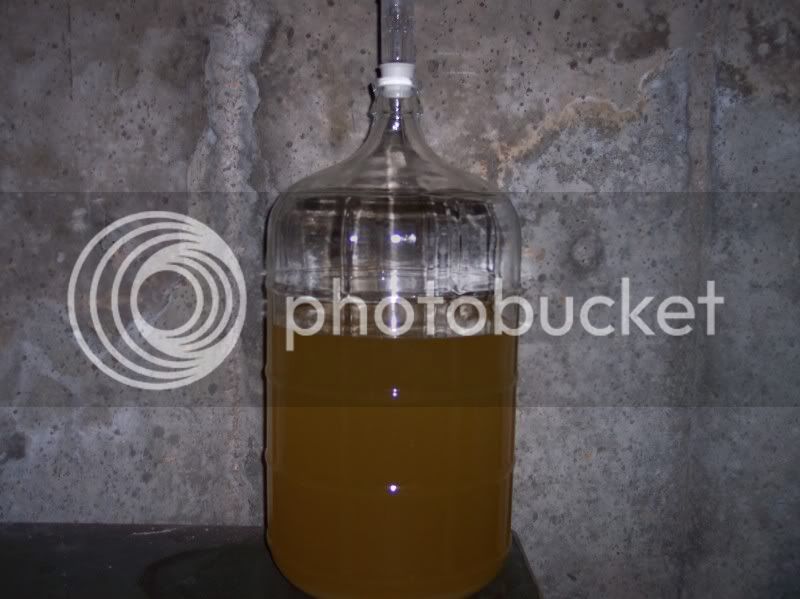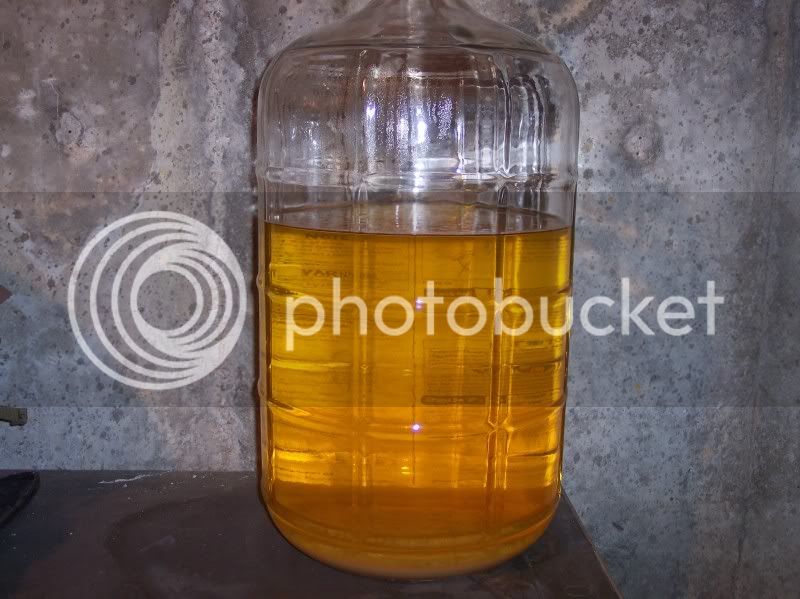Superlite27
Member
Hello all!
I happened across this forum while looking for answers about my first batch of mead (which is currently percolating right along) and after searching around, found a wealth of knowledge that answered many of my questions.
I decided to start brewing after I recently helped a friend clean out his shed. He had several bee hives and was going to BURN THEM! So I said "Hey! If you're gonna burn 'em....I'll take 'em!"
Looks like next year, I'm going to have a bunch of honey....
Now what am I to do with a bunch of honey?
So I went to my local beer and wine store and got some equipment and enough advice to get me in up to my neck.
My first batch I currently have is
4 gal water
12 lb. of wildflower honey
4 pears peeled, cored, and blended
After sterilizing all my equipment, I put it all in a pot and brought it to 180 degrees for five minutes stirring continuously. I then cooled the pot by spraying it with cool water from a garden hose, making sure not to contaminate it by spraying anywhere near the lid. After several hours, it had cooled to around 90 degrees, so I tranferred it to my primary fermenter (6 gal plastic bucket) and let it sit on the counter overnight.
In the morning, it had cooled to 77 degrees, so I reconstituted a packet of Lalvin K1-V1116 according to packet directions and blended it with half a teaspoon of nutrient into my primary fermenter.
I figured the blended pears would help provide nutrients for the yeast, so I cut back the 1 tsp of nutrient I was going to add to 1/2 tsp. (the directions called for 1/8 - 1/4 tsp per gal.) ....so I went on the low side.
It has been almost two weeks (12 days) and the airlock is bubbling about 1 every 17 seconds. (At 2 days it was at about 1 every 10) so it is slowing down.
Now, for some info...I am not very "scientificly" minded. I often read about hydrometers and specific gravities etc....ad infinitum. I can guess that this is pretty much the standard. I'm guessing the majority of folks brew "by the numbers"....but sorry....I apologize ahead of time. Not me. I may get tons of advice about how I should probably, at least try using one....but it's probably not gonna happen. Maybe sometime in the future. Maybe.
Until then...I'm stickin' to the way the cavemen did it. Trial and error.
Although, I still welcome advice! Any ideas on how I'm doing? Any suggestions? Have I mistakenly screwed something up beyond repair without noticing yet? What do you think of my methodology? (I know, I know...I should probably get a specific gravity reading!)
I really admire the scope and wonderful information in this forum and look forward to participating here!
BTW: I'm debating on racking into my secondary sometime next week. I'm a little shaky on what this will do. Will this have any effect on the sweetness or dryness of the mead? K1-V1116 is a fairly high alcohol tolerant yeast, will racking to my secondary have any effect? Will leaving it longer in the primary "kill off" more yeast causing it to be sweeter, or will racking sooner aerate, causing renewed "breeding", therefore, dryer mead?
I plan on just leaving the secondary alone for awhile (no hurries) unless the lees build up, then racking possibly a second time or just bottling.
How'm I doin'?
I happened across this forum while looking for answers about my first batch of mead (which is currently percolating right along) and after searching around, found a wealth of knowledge that answered many of my questions.
I decided to start brewing after I recently helped a friend clean out his shed. He had several bee hives and was going to BURN THEM! So I said "Hey! If you're gonna burn 'em....I'll take 'em!"
Looks like next year, I'm going to have a bunch of honey....
Now what am I to do with a bunch of honey?
So I went to my local beer and wine store and got some equipment and enough advice to get me in up to my neck.
My first batch I currently have is
4 gal water
12 lb. of wildflower honey
4 pears peeled, cored, and blended
After sterilizing all my equipment, I put it all in a pot and brought it to 180 degrees for five minutes stirring continuously. I then cooled the pot by spraying it with cool water from a garden hose, making sure not to contaminate it by spraying anywhere near the lid. After several hours, it had cooled to around 90 degrees, so I tranferred it to my primary fermenter (6 gal plastic bucket) and let it sit on the counter overnight.
In the morning, it had cooled to 77 degrees, so I reconstituted a packet of Lalvin K1-V1116 according to packet directions and blended it with half a teaspoon of nutrient into my primary fermenter.
I figured the blended pears would help provide nutrients for the yeast, so I cut back the 1 tsp of nutrient I was going to add to 1/2 tsp. (the directions called for 1/8 - 1/4 tsp per gal.) ....so I went on the low side.
It has been almost two weeks (12 days) and the airlock is bubbling about 1 every 17 seconds. (At 2 days it was at about 1 every 10) so it is slowing down.
Now, for some info...I am not very "scientificly" minded. I often read about hydrometers and specific gravities etc....ad infinitum. I can guess that this is pretty much the standard. I'm guessing the majority of folks brew "by the numbers"....but sorry....I apologize ahead of time. Not me. I may get tons of advice about how I should probably, at least try using one....but it's probably not gonna happen. Maybe sometime in the future. Maybe.
Until then...I'm stickin' to the way the cavemen did it. Trial and error.
Although, I still welcome advice! Any ideas on how I'm doing? Any suggestions? Have I mistakenly screwed something up beyond repair without noticing yet? What do you think of my methodology? (I know, I know...I should probably get a specific gravity reading!)
I really admire the scope and wonderful information in this forum and look forward to participating here!
BTW: I'm debating on racking into my secondary sometime next week. I'm a little shaky on what this will do. Will this have any effect on the sweetness or dryness of the mead? K1-V1116 is a fairly high alcohol tolerant yeast, will racking to my secondary have any effect? Will leaving it longer in the primary "kill off" more yeast causing it to be sweeter, or will racking sooner aerate, causing renewed "breeding", therefore, dryer mead?
I plan on just leaving the secondary alone for awhile (no hurries) unless the lees build up, then racking possibly a second time or just bottling.
How'm I doin'?




